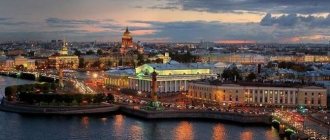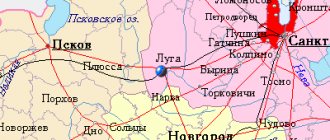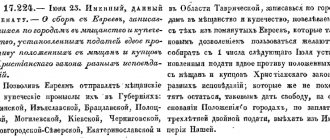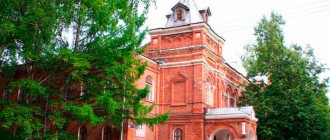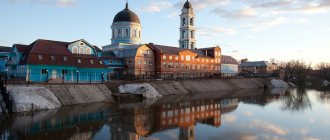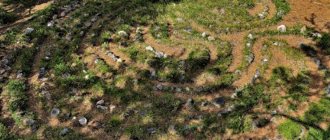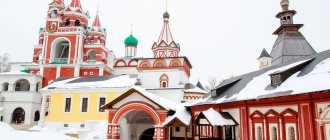Founded: 1216
Rzhev celebrates City Day on
the last Saturday of June
.
In 2022,
this date is
June 25
.
City on the Volga
Rzhev
is a Russian city in the southwest of the Tver region, located 200 km from the source of the Volga, west of Moscow. The city got its name from the word “rust”, referring to springs with ferruginous brown water and rusty swamps.
The name of the city was first mentioned back in 1216
in the Novgorod First Chronicle. It is said that the Vladimir-Suzdal prince Svyatoslav Vsevolodovich besieged “Rzhevka, the town of Mstislavl.” However, archaeological finds confirm that people settled on the territory of the Rzhev Volga region starting from 10 thousand BC. At least 200 sites of hunters and fishermen found during excavations have been recorded.
And then, in the Middle Ages, a place for the city was chosen that was not only convenient, but also inaccessible for attack. Rzhev was located on the western border of Russian lands and had a favorable trade and economic position - of course, this was worth the struggle of the feudal principalities. For more than one century, Rzhev belonged to different principalities: Smolensk, Tver, Moscow, and a battle was fought for it with Lithuania.
Obelisk to the liberators of Rzhev (Photo: wikipedia.org) Throughout its history, the city has constantly participated in battles. In 1606, residents supported the uprising of Ivan Bolotnikov. During the period of "turmoil" Rzhev was ruined by more than half. Impostors, Poles, Swedes - whose foot never set foot on Rzhev at that time. In the 17th and 18th centuries, when peasant unrest took place throughout Rus', Rzhev was also among the rebellious cities. The city was not spared by the Patriotic War of 1812.
But perhaps the darkest page in Rzhev’s life was the 17 bloody months during the Great Patriotic War. The city was captured on October 14, 1941 by Nazi tanks and infantry. Executions, abductions into slavery, robberies and fires - the residents of Rzhev experienced all this to the fullest. All industrial enterprises and social institutions were destroyed, park areas were burned, and train stations were blown up. According to some reports, about 10 thousand people died in the camps near Rzhev. Another 50 thousand Rzhevites were destroyed during the occupation. On the day when the city was liberated from the Nazi invaders - March 3, 1943 - a little more than 300 people remained alive in Rzhev. However, despite the gigantic losses of Soviet soldiers, Rzhev was never captured by the Germans.
For the courage shown by Soviet soldiers during the Great Patriotic War, Rzhev was awarded the Order of the Patriotic War, 1st degree, and by Presidential Decree in 2007, Rzhev was awarded the honorary title “City of Military Glory”
.
Church of the Okovets Icon of the Mother of God (Photo: wikipedia.org)
Currently, Rzhev occupies 56 square meters. km, about 57 thousand people live here (2020).
After the war, only ruins remained of the city, and a completely new city was built on them. Today Rzhev is an environmentally friendly and militarily strategically important city. In memory of the victory in the Great Patriotic War, festivals, competitions and other festive events are constantly held here.
On the territory of the city
there is a Memorial War Cemetery, Alley of Heroes of the Soviet Union, Izba-Museum of I.V. Stalin, Steam locomotive-monument to Rzhev railway workers. Those interested can see the remains of the military fortress, visit the Cathedral of the Okovets Icon of the Mother of God, and the Church of the Ascension of the Lord.
Day of the city
Rzhev is celebrated on the last weekend of June.
Regional leaders
Igor Rudenya has recently been appointed over all districts of the Tver region. He was elected governor in September 2016, when the president nominated him to this position. In this post, he replaced Andrei Shevelev, who served as head of the region for 5 years.
The new government managed to achieve an improvement in the economic situation in the region; over the past 5-6 years, the Tver region has risen in the international economic rankings by several points. The number of investments in the region has also increased; large foreign and Russian companies have begun to invest more and more in local businesses.
Age and gender composition
As throughout the world, the prosperity of a region is determined by the ratio of young and old people. If a lot of young people live in an area and children are born, it means that it is promising and is developing correctly; it is not profitable for the new generation to leave here.
According to the latest census in the Tver region, there are more women than men by 10-12%. But the same indicators are observed throughout Russia. And the number of working-age population is not much greater than the number of people of retirement age.
Famous people
Many famous people were born and lived in the Tver region.
- Afanasy Nikitin, famous traveler, orientalist, the first Russian to reach India, author of the famous book “Walking across Three Seas.”
- Arseny Ivanovich Vvedensky is a Russian critic, literary historian, and has written hundreds of books about Russian writers.
- Khitruk Fedor Savelyevich, famous Russian animator, creator of the favorite cartoon about Winnie the Pooh.
- Mikhail Krug, singer, author and composer, became famous throughout Russia for his songs in the chanson style. Died at the hands of robbers.
In addition, more than 20 heroes of the Soviet Union were born in the region, who distinguished themselves during the Great Patriotic War. Almost all famous citizens in the city have monuments, monuments or plaques of honor.
Crime
The cities of the Tver region have been in crime news more than once. Back in the early 90s, as throughout the country, bandits or “new Russians” operated here. Among all, the Tver Wolves gang stood out, committing murders in the region for several years. The leader of the gang, Alexander Kostenko, or Lom, already in the late 90s took over almost the entire shadow business of Tver. The group, in addition to fighters and killers, included corrupt officials, well-versed lawyers and some security officials.
The manner in which the Tver Wolves conducted business kept the entire population of the cities of the Tver region in fear. From obedient and faithful people, Lom put together a brigade of terrorist killers, they did not spare anyone and acted on the principle “the more victims, the better.”
They killed their enemies en masse, for everyone to see, to demonstrate their power and avoid any disobedience. One of their bloodiest crimes was the massacre of the market director’s family; the killers spared no one, not the director’s wife, nor his two minor children. It is this gang that is suspected of murdering the famous singer Mikhail Krug.
One of the latest high-profile cases is the murder of 9 people in the Tver region. The tragedy occurred in June 2022, when in a friendly cooperative Sergei Egorov without regret dealt with 9 people, sparing no one, not even an old disabled woman. This story thundered throughout the country; Yegorov himself practically did not give interviews, once telling reporters that he killed people because they laughed at him. In the fall, Egorov was sentenced to life imprisonment.
Facts about the residents of the region
The population of the Tver region: the number of Russians is 92%, of other peoples the largest number are Ukrainians - 1.5%, Armenians - 0.5% and the small peoples of Tver Karelians, just over 14 thousand people live in the region. In addition, Chuvash, Germans, Chechens, Moldovans, Georgians and Uzbeks were registered here.
In the region there are 23 cities of varying density, mostly with a population of no more than 30-40 thousand people, with the exception of the city of Rzhev with 59 thousand population.
RZHEV
RZHEV, a city in Russia, in the Tver region, the center of the Rzhev district. Us. 60.8 thousand people (2014). Located on the river. Volga. Railway node Near south The federal highway "Baltic" (Moscow - Volokolamsk - border with Latvia) runs along the outskirts of the city.
View of Rzhev. Artist A. Ya. Voloskov. 1856. Rzhev Museum of Local Lore.
Probably founded in con. 12 – beginning 13th centuries book Vladimir Mstislavich (? – not earlier than 1225/26). It was first mentioned in 1216 in the First Novgorod Chronicle and a number of other chronicles. In the 13th–14th centuries. center of the Rzhev principality. Until the 18th century in many official in documents it was called Rzhev (from the 16th century Rzhev Volodimerova). Fortifications of the 13th–17th centuries. were located on the left bank of the Volga, on the cape settlement of Sobornaya Gora, and included Detinets (approx. 120×60–80 m, protected by a ditch up to 9 m deep) and a round town (approx. 130×90 m). There was a tree in the child. Assumption Cathedral. In the 2nd half. 14 – 1st floor. 15th centuries R. is the object of the struggle between Vel. Prince of Lithuania, Moscow. and Tverskoy led. principalities. In 1381–82 it became part of Moscow. kn-va. In 1399 (until the early 1400s) and 1446 (until 1448) the Vel. princes of Tver. In 1408 a tree was erected on Detinets. fortress (rebuilt several times, existed until the beginning of the 18th century). In Jan. 1448 Lithuania captured. troops, but according to Russian-Lithuanian. Treaty 1449 assigned to the leader. princes of Moscow. In 1462–1513 it belonged to the Prince of Volotsk. Boris Vasilyevich and his sons Fyodor and Ivan Borisovich, in 1503 the unfortified right bank part of the river was transferred to the Uglich prince. Dmitry Ivanovich Zhilka. Gor. posad from the 15th century. was located on both banks of the Volga (on the left bank - Prince-Fedorovskaya side, on the right bank - Prince-Dmitrievskaya; names early 16th century). On the right bank at the beginning. 16th century Novgorod craftsmen erected a brick single-domed Spaso-Preobrazhensky Cathedral (destroyed in 1943). From 1521 R. was ruled by Moscow. governors. During the Time of Troubles it was captured twice by the troops of False Dmitry II (1609, 1610), and in 1613 it withstood the attack of A. Lisovsky’s detachment. Until the 1660s the city was preserved by the military. significance, had a large garrison and was a collection point for Russians. troops during the Russian-Polish wars of the 17th century.
District city of St. Petersburg. (until 1710 Ingria) province. (1708–19), Tver Prov. St. Petersburg (1719–27) and Novgorod (1727–75) provinces, Tver province. (1775–1929; until 1796 Tver governorship). Railway traffic is open. lines Torzhok - Rzhev (1874), Rzhev - Vyazma (1888), Moscow - Zilan (1901, passed through R.). District (since 1929) and district (1929–30) center of the West. (1929–1935) and Kalinin (from 1990 Tver) regions (from 1935). In Vel. Otech. war, 10/14/1941, Germany occupied. troops, in the vicinity of R. the Rzhev operations of 1942–43 took place, the city was almost completely destroyed. Liberated on March 3, 1943 during the Rzhev-Vyazemsk offensive. operations.
In the right bank part of the Republic there are preserved temples: an Empire style church. Okovetskaya Icon of the Mother of God (1818–21; bell tower 1830–41), 5-domed Ascension Cathedral in the Russian-Byzantine style (1856–1860), Old Believer Pokrovskaya Church. (1908–10, architect N. G. Martyanov). Among the buildings is the 2nd floor. 18 – beginning 20th centuries: houses of the merchants Obraztsov (1st third of the 19th century), P.I. Myasnikov (mid-19th century), former. estate of the merchant Tsybin (1894), former building. branches of the banking house "Ryabushinsky Brothers" with elements of neo-Russian style (1908). Built in the neoclassical style: the so-called. Kalinin houses (late 1930s), railway Rzhev-Baltiysky station (1952). Church of the New Martyrs and Confessors of Russia (1995–2005). Local history specialist museum (1916; since 1998 in the former chambers of the Nemilov merchants of the 2nd half of the 18th century).
Mechanical engineering enterprises (main products - automotive electrical equipment, tower cranes, tank trucks, welding, foundry, thermal equipment), woodworking, light and food industries; production of building materials.
To the east on the outskirts of R. - the ancient settlement of Troitskaya Gora, the remains of the detinets of the city of Opoki (first mentioned in 1399, as part of the Tver Grand Prince until 1485, destroyed in 1613). Near the river, in the Shutovo tract, there is Pokrovskaya Ts. (1771–76).
Pastime of the population
There are many monuments of historical and cultural heritage in Tver and the region. There are especially many preserved monasteries and temples, some of which are more than 500 years old. The Ascension Cathedral in Tver was built in the mid-18th century and today has the status of a bishop's courtyard. The church burned more than once and was rebuilt; today the relics of the holy martyr Thaddeus are kept here.
A real work of art is the Staritsky Holy Dormition Monastery, which is located in a picturesque location on the banks of the Volga. The monastery was founded in the 12th century, but the first buildings have not survived to this day and were destroyed in the 14th century. Almost a hundred years later, the monastery was rebuilt from scratch; it is these white stone buildings that have survived today.
The unique temple is located in the city of Torzhok; the wooden building, built in the 18th century, has stood with minimal restoration for more than 200 years. Even a painting from the mid-18th century has been preserved in almost intact condition.
Where do residents of the Tver region live?
The Tver region and Tver are located on a flat territory; the region is practically devoid of mineral resources. Coal mining stopped here a few years ago, but there are large deposits of peat. The main river is the Volga, and many tributaries flow here and several reservoirs have been created - Rybinskoye, Verkhnevolzhskoye, Ivankovskoye and Uglichskoye. It is in the Tver region that the today famous Lake Seliger is located - a place for political meetings of young people and the country's top leadership.
The area of the Tver region is slightly more than 82 thousand square meters. km, is considered the 38th largest in area among Russian regions. Most of the territory is occupied by broad-leaved, mixed and coniferous forests, rich in flora and fauna. The vast Orsha swamp is also located here. Until recently, peat extraction work was carried out here. Development is currently underway, but at a slower pace due to poor demand for this resource.


